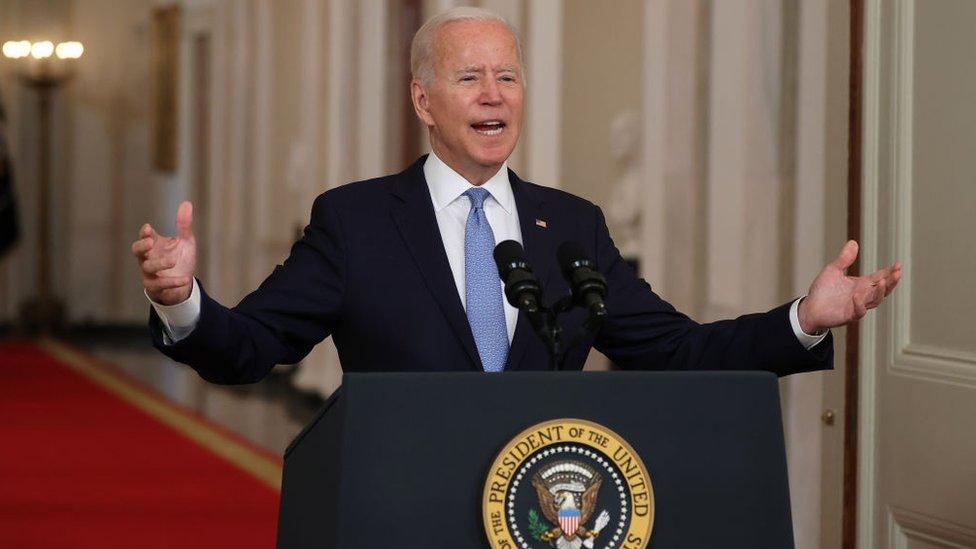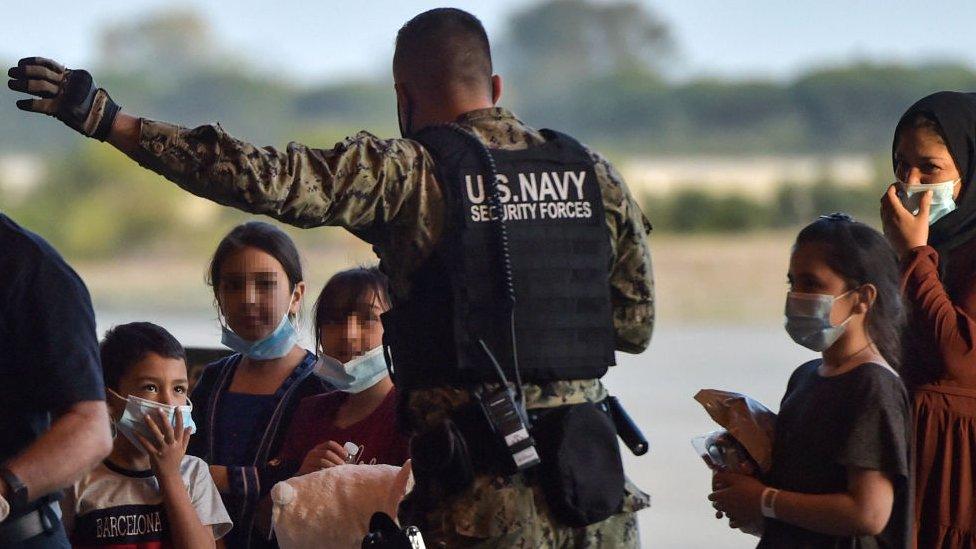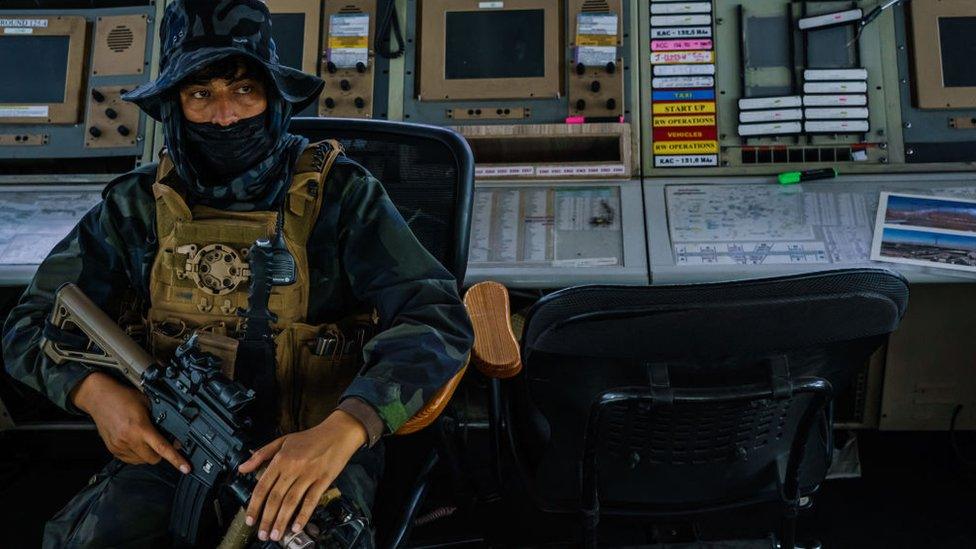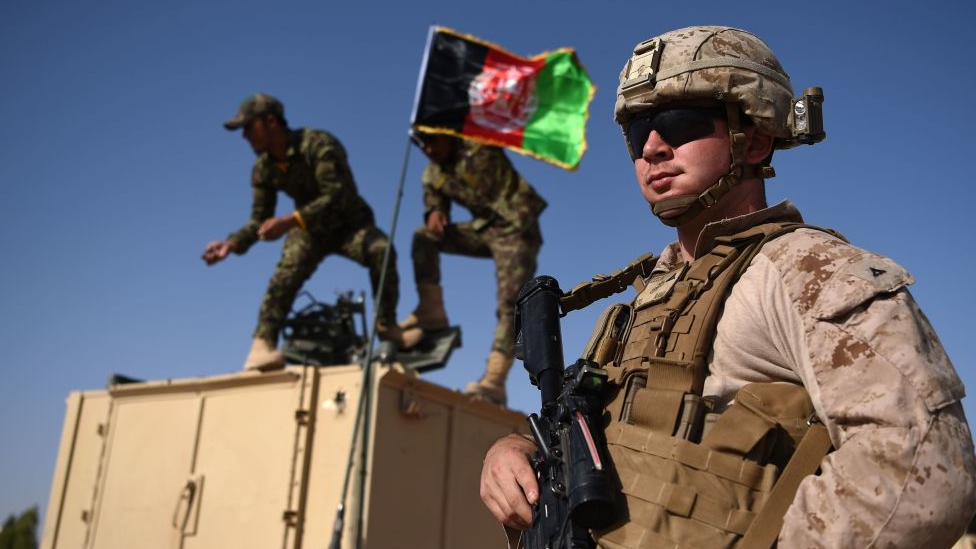Afghanistan: Joe Biden speech on withdrawal fact-checked
- Published

In a televised address following the final departure of US troops from Afghanistan, President Joe Biden made a series of assertions about US policy in the country.
We've fact-checked some of his claims, comparing them with his earlier statements and the situation on the ground.
'90% of Americans in Afghanistan who wanted to leave were able to leave'
Mr Biden said this in his speech on Tuesday.
However, two weeks ago (on 19 August) he told ABC News that "if there are American citizens left" after the 31 August withdrawal deadline, then "we're going to stay until we get them all out".
US officials estimate that up to 200 Americans were left behind after the departure of the last US troops from Afghanistan.

The US says more than 120,000 people were airlifted out of Afghanistan in August
The Pentagon has confirmed that some American citizens tried to reach Kabul airport for the last evacuation flights, but were unable to do so.
The US is in negotiations with the Taliban and neighbouring countries to secure safe travel routes which don't involve the US military for people who want to leave, such as overland passage and chartered flights.
Donald Trump authorised 'the release of 5,000 prisoners last year, including some of the Taliban's top war commanders'
It's true that the Trump administration reached a deal last year to release 5,000 Taliban members in exchange for 1,000 Afghan security force prisoners.
This swap was finally completed in September 2020, when more than 400 Taliban prisoners who had committed "major crimes", according to the Afghan government,, external were eventually given their freedom following pressure from the US.
So were there Taliban "top war commanders" among those released?
Afghan government officials certainly believe there were and had told the Americans of their concerns., external

Taliban militants are now in control of Kabul airport following the final US troop withdrawal
Reported to have been among them was Mawlavi Talib, a senior Taliban commander, external who oversaw the attack on the southern Afghan city of Lashkargah.
It is also important to note that other Taliban commanders were released long before the Trump administration's agreement.
For example, several senior members of the Taliban were released from Guantanamo Bay during the Obama administration in 2014 as part of a prisoner exchange.
'More than $2 trillion spent in Afghanistan... [or] you could take the number of $1tn, as many say'
The vast majority of troops and spending in Afghanistan came from the US.
According to the US Department of Defense, the total military expenditure in Afghanistan (from October 2001 until December 2020) had reached $825bn, with about another $130bn spent on reconstruction projects., external
That brings the total cost, based on official data, to $955bn between 2001 and 2020 - close to the lower $1tn estimate given by Mr Biden.
But the president also pointed to a $2tn figure, which is based on a recent study by Brown University.
This study also includes spending in Pakistan, which the US used as a base for Afghan-related operations, and runs through to the 2022 fiscal year based on requested money.
It found that costs of the war in Afghanistan from 2001 to 2022 would amount to $2.3tn., external
The figure includes interest on debt used to finance the war and expenses like veterans' care.
US mission in Afghanistan morphed into 'nation building'
In his televised address, Mr Biden highlighted how America's goal in Afghanistan had developed from a counter-terrorism operation to nation building.
Last week he made a similar point, stressing the purpose behind the US intervention in Afghanistan had "always been preventing a terrorist attack on American homeland" and was "never supposed to be creating a unified centralised democracy".
This clearly contradicts his previous positions on the US objective in Afghanistan.

At the outset of the conflict in 2001 when Mr Biden was a US senator, he outlined the long-term purpose of the American military intervention, saying: "Our hope is that we will see a relatively stable government in Afghanistan, one that… provides the foundation for future reconstruction of that country."
And again, in 2003 - in another quote, tracked down by the Politico website, external - he said the "alternative to nation building is chaos, a chaos that churns out bloodthirsty warlords, drug traffickers and terrorists".

